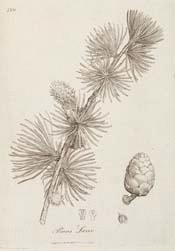
Botanical.com Home Page

|
Pine (Larch)
(Pinus larix D.C.)
Click on graphic for larger image
|
Pine (Larch)
Botanical: Pinus larix (D.C.)
Family: N.O. Coniferae
---Synonyms---Larix Europaea. Abies larix. Larix decidua. Laricis Cortex. Meleze. European Larch. Venice Turpentine.
---Part Used---The bark, deprived of its outer layer.
---Habitat---Central Europe.
---Description---'Larix' was the name given to Pine resin in the time of Dioscorides, and the term has been kept for these lofty trees. The leaves, bright green in spring, grow in small, spreading tufts like brushes. The male catkins, 1/2 inch long, are sessile and ovoid, with a cup of persistent bracts and inner, resinous, fringed, brown scales. The female cones, 3/4 inch long, grow on short stalks, with hard, greyish-brown scales.
Larch is only indigenous to the hilly regions throughout Central Europe, where it forms large forests in the Alps, but it has for long been largely cultivated throughout Europe. It was first introduced into England in 1639.
It is one of the most valuable trees ever introduced into the country, both with respect to the rapidity of its growth (it grows six times quicker than Oak) and the value of its durable timber. Its wood is far tougher, stronger and more durable than that of any other conifer, excepting perhaps the Yew. Its durability makes it specially adapted for mining operations and there is also considerable demand for it for railway sleepers, because it lasts longer than any other kind of home-grown wood when under the wear and tear of traffic and the decomposing influence of damp, warmth, and fungi. It is also employed both in ship- and house-building, and in Cabinet-work is capable of taking a very high polish. Gilding has a better effect on it than over almost any other, and it is a favourite for placing behind pictures, as it resists worm attacks. It is the one wood for which a ready sale can always be found in any part of the United Kingdom.
None of our forest trees is hardier than the Larch. The young trees establish themselves readily and soon grow rapidly. They are therefore, like the birch, used as 'nurses' for slow-growing and less hardy kinds of trees. The ground beneath a larch wood speedily improves in quantity and quality.
Large quantities of turpentine are collected from full-grown trees from May to October, holes being bored in the trunk and wooden tubes inserted. The exudation that flows is perfectly clear and needs no further preparation than straining through a coarse hair-cloth to free it from impurities. It was used in medicine and for making several kinds of varnish. In commerce it is known as 'Venice Turpentine,' being formerly exclusively exported from Venice. It is produced now mainly in the Tyrol, Switzerland, and Piedmont.
The frequently-found substitutes may be detected by their strong odour, and by drying into a hard varnish when painted on paper. The bark, which is not official in India or the United States, should be removed and stripped of its roughest outer portion in spring, and dried rapidly. In commerce it is found in flat pieces or quills of various sizes. The outer surface is rosy in colour, and the inner either yellowish or pinkish, easily separating into layers. It breaks with a close fracture, excepting the whitish fibres. The odour is a little like balsam and terebinth, and the taste astringent. The bark is sometimes used for tanning, but is inferior to oak, so that in Britain it is not always worth the cost of peeling and carriage.
[Top]
---Constituents---The bark contains tannic acid, larixinic acid and turpentine. The larixin, a crystalline principle, resembles pyrogallol.
Briançon Manna is exuded from the leaves in summer. It is white and sweet, occurring in oblong tears and almost odourless. Its peculiar sugar is termed Melezitose. Its use is obsolete.
If the trees are burnt, a gum exudes from the trunk called Gummi Orenbergense, soluble in water like Gum Arabic.
---Medicinal Action and Uses---Stimulant, diuretic, astringent, balsamic and expectorant. As an external application it has been found useful in chronic eczema and psoriasis. Its chief official use is as a stimulant expectorant in chronic bronchitis, with much secretion. Its action is that of oil of turpentine.
It has also been given internally in haemorrhage and cystitis.
The turpentine is used in veterinary practice. It has been suggested for combating poisoning by cyanide or opium, and as a disinfectant in hospital gangrene.
---Dosage---Of B.P. Tincture Laricis, 20 to 30 minims. Venice Turpentine.
See TAMARAC.
[Top]
Common Name Index
A MODERN HERBAL Home Page
Bear in mind "A Modern Herbal" was written with the conventional wisdom of the early 1900's. This should be taken into account as some of the information may now be considered inaccurate, or not in accordance with modern medicine.
© Copyright Protected 1995-2024 Botanical.com
|

